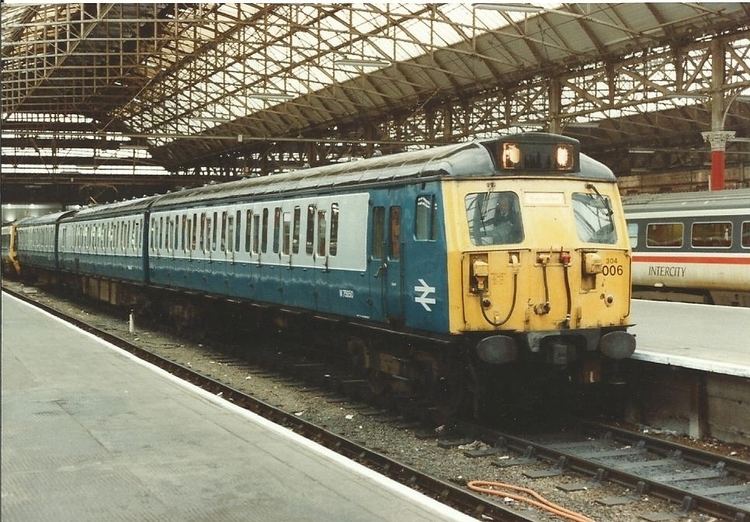Family name BREL 1972 "PEP" Operator(s) SELNEC (planned) | Formation 3/4 cars per set Depot(s) Queens Road (planned) | |
 | ||
Line(s) served Picc-Vic network (planned) | ||
The Class 316 was a proposed type of electric multiple unit intended for use on planned urban rail services in Greater Manchester. Intended as part of the family of EMUs descended from the prototype "PEP" stock, the class was never proceeded with as the planned services for which it was to be built were cancelled.
Contents
"Picc-Vic" proposal
In 1971, the South-East Lancashire and North-East Cheshire (SELNEC) Passenger Transport Executive, the body responsible for public transport in and around the greater Manchester area, proposed the construction of a new underground railway tunnel intended to link Manchester's two remaining major railway termini, Piccadilly and Victoria, to create a new urban metro network. This tunnel, nicknamed the "Picc-Vic", was intended to link the disparate rail networks to the north (from Victoria) and south (from Piccadilly) of the city for the first time, allowing services through the centre of Manchester. At the time, the planned routes that would have been joined to the tunnel were a mix of electrified and non-electrified; the Bury Line, from Victoria, used a unique, 1200V DC third rail system; the Buxton line was unelectrified, while the Styal, Crewe and Stafford lines were all electrified using 25kV AC from overhead wires (OHLE). The proposal would have seen the entire planned network run using OHLE, which had recently been fitted to the West Coast Main Line as far as Manchester Piccadilly. As a consequence of this, new rolling stock was planned to operate the proposed services.
PEP rolling stock
Because of the requirements of operating in the central tunnel section, the initial SELNEC specification for new trains stated that they would require both sliding doors and end connections, which did not feature together on then current rolling stock operated by British Rail. The initial publicity for the Picc-Vic plan, which was described as "Manchester's tube project", showed an artist's impression of a platform with a train resembling the 1967 Stock, as used on the Victoria line in London. However, the twin bore tunnels were intended to be built with a diameter of 18 ft (5.5 m), large enough to accommodate both a main line train type, and the OHLE wires.a
At the same time, British Rail was in the midst of testing a new suburban train type in the Southern Region. These prototype units, eventually designated as Class 445 and 446 under the Total Operations Processing System (TOPS), were different to any rolling stock that had come before; they were constructed of aluminium rather than steel, were an all in one design rather than a coach body on top of a separate underframe, and had sliding doors. Although the Class 445 and 446 were only prototype units, the information garnered from their use, both in initial testing and passenger service in the Southern Region, and later in departmental use as testbed units, led to the production of a new series of suburban EMUs that came into use in the mid to late 1970s.b
In 1975, SELNEC (by then renamed as the Greater Manchester Passenger Transport Executive) published a new Picc-Vic publicity brochure that went into greater detail about the potential type of rolling stock that would be used, with an image of a Class 445 unit used to indicate the proposed type of train. The front cover also had an artist's impression of a train resembling the new types then in development for the urban networks in London, Liverpool and Glasgow. To fit with the TOPS classification of the other types powered via OHLE, the planned units for Manchester were assigned as Class 316.
The Class 316 units were intended to replace a mix of different types - the unelectrified Buxton line (which would have had services as far as Hazel Grove) was predominantly operated by Class 104 DMUs. Other services from Piccadilly were primarily operated by Class 304 EMUs, while Class 504 units operated over the uniquely electrified Bury line from Victoria.
Cancellation
Although specifications for the Class 316 units were prepared by the British Rail Research Division at Derby, no concrete tender proposals were issued to prospective manufacturers before the final cancellation of the Picc-Vic project in 1977.
Subsequent cross-city connection
Following the cancellation of the Picc-Vic project, the GMPTE came up with an alternative proposal for a street based light rail network, which would take over the Bury line (as envisaged in the Picc-Vic plan), and the line from Manchester Piccadilly to Altrincham, which would be joined by an on-street tram route. This eventually became Phase 1 of the Manchester Metrolink, which utilized a new-build fleet of 26 light rail vehicles classed as T-68 and procured from AnsaldoBreda. This fleet, which eventually numbered 32, was replaced at the end of 2014 by the M5000 type from Bombardier.
